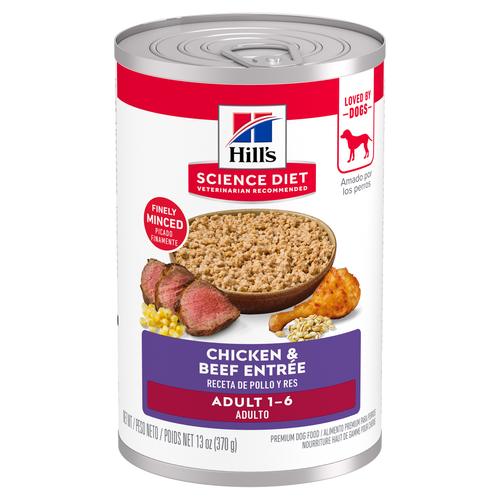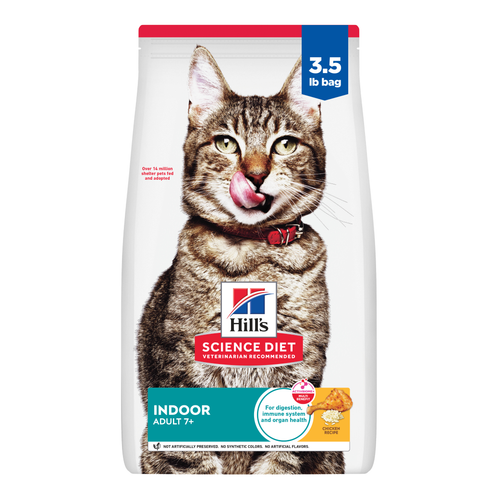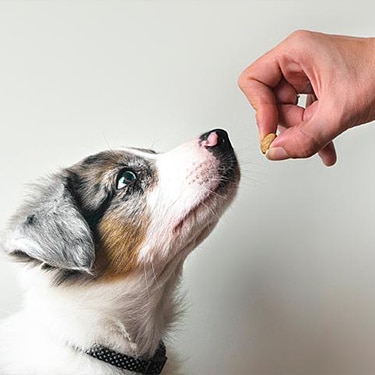
-
Find the right food for your petTake this quiz to see which food may be the best for your furry friend.Find the right food for your petTake this quiz to see which food may be the best for your furry friend.Featured products
 Adult Large Breed Chicken & Barley Recipe Dog Food
Adult Large Breed Chicken & Barley Recipe Dog FoodSupports healthy joints, lean muscle, and beautiful coat for large breed dogs
Shop Now Adult Chicken & Barley Recipe Dog Food
Adult Chicken & Barley Recipe Dog FoodSupports lean muscle and beautiful coat for adult dogs
Shop Now Hill's Science Diet Adult Chicken & Beef Entrée Dog Food
Hill's Science Diet Adult Chicken & Beef Entrée Dog FoodChicken & Beef Entrée in a delicious loaf with complete & balanced nutrition to help keep adult dogs active and healthy
Shop NowFeatured products Adult Turkey & Liver Entrée Cat Food
Adult Turkey & Liver Entrée Cat FoodPrecisely balanced nutrition with the delicious taste of minced turkey & liver to help fuel the energy needs of cats during the prime of their life
Shop Now Adult 7+ Indoor Chicken Recipe Cat Food
Adult 7+ Indoor Chicken Recipe Cat FoodSupports energy level and beautiful fur in mature indoor cats
Shop Now Senior Vitality Adult 7+ Tuna & Vegetables Stew
Senior Vitality Adult 7+ Tuna & Vegetables StewImproves Everyday Ability to Get Up & Go
Shop Now -
Dog
- Dog Tips & Articles
-
Health Category
- Weight
- Food & Environmental Sensitivities
- Urinary
- Digestive
- Joint
- Kidney
-
Life Stage
- Puppy Nutrition
- Adult Nutrition
- Senior Nutrition
Cat- Cat Tips & Articles
-
Health Category
- Weight
- Skin & Food Sensitivities
- Urinary
- Digestive
- Kidney
-
Life Stage
- Kitten Nutrition
- Adult Nutrition
Featured articles The Science Behind Our Love for Pets
The Science Behind Our Love for PetsLearn the scientific reasons why we have such strong connections with our pets, and what science says about the love between humans and our furry friends.
Read More What Is Littermate Syndrome? Pet Adoption Guide
What Is Littermate Syndrome? Pet Adoption GuideLearn more about littermate syndrome in dogs and cats and how to successfully navigate adoption and early socialization processes.
Read More How to Properly Mix Wet & Dry Pet Foods
How to Properly Mix Wet & Dry Pet FoodsAn Orange cat eating from a bowl filled with mixed food
Read More -


Dogs are curious. They love to run and chase things including insects, which in some cases protect themselves by stinging the dog.

Multiple stings are dangerous. Most of the time, an insect sting is just painful and irritating for your dog. Getting stung several times, or stung inside the mouth or throat, is dangerous and requires a trip to the veterinarian.
Bee and wasp stings are poisons. The two most common types of stinging insects are bees and wasps. It’s not the small puncture wound that causes the sting's pain, but the small amount of poison that is injected.
- A bee’s stinger is barbed and designed to lodge in the skin, killing the bee when the stinger detaches from the body
- Wasp stingers are not barbed but are more painful, and if provoked these insects can sting multiple times
Most of the time dogs get stung on their faces from investigating a stinging insect too closely. A sting on your dog’s sensitive nose is particularly painful. Some dogs may even get stung on the tongue or inside their mouth or throat if they try to bite or catch an insect. These stings can be dangerous., The subsequent swelling can close your dog’s throat and block his airway.


Tasty Tips
Watch for allergic reactions. A severe reaction can be caused by a large number of stings or by an allergic reaction. Signs of a reaction include:
- General weakness
- Difficulty breathing
- A large amount of swelling extending away from the sting site
If your dog is having a severe reaction, you need to take the dog to a vet immediately.
A simple sting can be safely left alone. It should be bothersome only temporarily. If a stinger is still present, try to remove it by scraping it with a fingernail or a rigid piece of cardboard. Avoid using tweezers or forceps to remove it unless absolutely necessary as this may force more venom out of the stinger.
Administer a remedy for the pain. Applying a weak mixture of water and baking soda to the affected area will help reduce the pain. You can also wrap ice or an icepack in a towel and apply it to the wound to reduce swelling and pain.
Maintain a watchful eye on your dog. Observe your dog closely after the sting incident to ensure an allergic reaction doesn’t develop. If several days pass and the swelling doesn't go down, notify your veterinarian.
Read more Hill’s dog care tips and discover how to choose the right Hill’s® Science Diet® dog food to meet your dog’s specific needs.
Related products

Chicken & Barley Entrée in a delicious loaf with great taste and precisely balanced nutrition to support 5 essential building blocks for lifelong health

Supports lean muscle and beautiful coat for adult dogs

Chicken & Beef Entrée in a delicious loaf with complete & balanced nutrition to help keep adult dogs active and healthy

Supports healthy joints, lean muscle, and beautiful coat for large breed dogs
Related articles

Can puppies have treats? Explore best practices for giving your puppy treats to ensure you're doing so in the healthiest way possible.

Discover how the field of dog science is giving us more and more insights into the inner workings of our furry best friends.

Wondering where can I buy a dog? Consider adoption and explore the pros and cons of adopting a dog from a breeder versus an animal shelter.

Learn how to help keep your dog's immune system in tip-top shape, including nutritional immune system support for dogs and other strategies.

Put your dog on a diet without them knowing
Our low calorie formula helps you control your dog's weight. It's packed with high-quality protein for building lean muscles, and made with purposeful ingredients for a flavorful, nutritious meal. Clinically proven antioxidants, Vitamin C+E, help promote a healthy immune system.
Put your dog on a diet without them knowing
Our low calorie formula helps you control your dog's weight. It's packed with high-quality protein for building lean muscles, and made with purposeful ingredients for a flavorful, nutritious meal. Clinically proven antioxidants, Vitamin C+E, help promote a healthy immune system.


